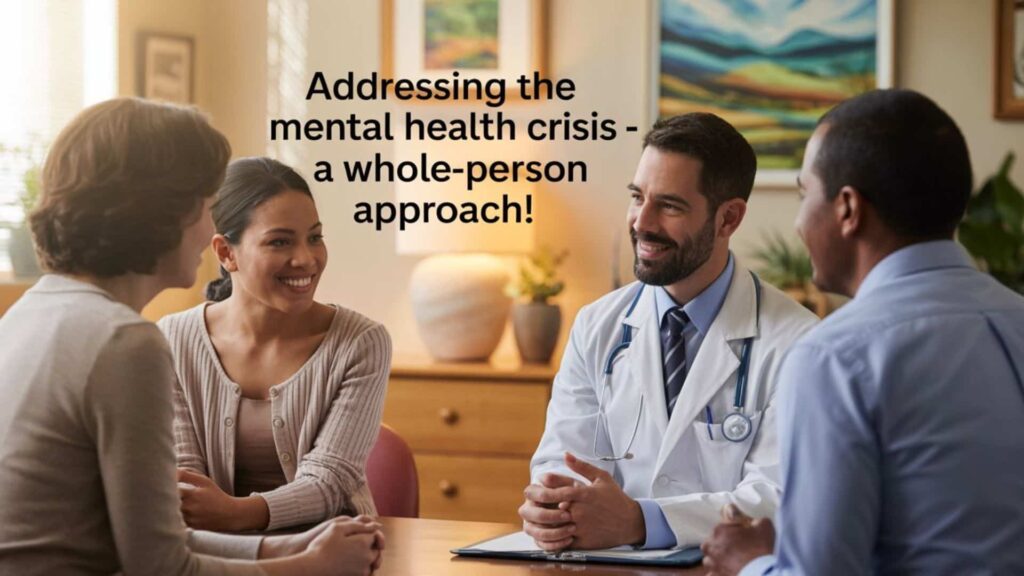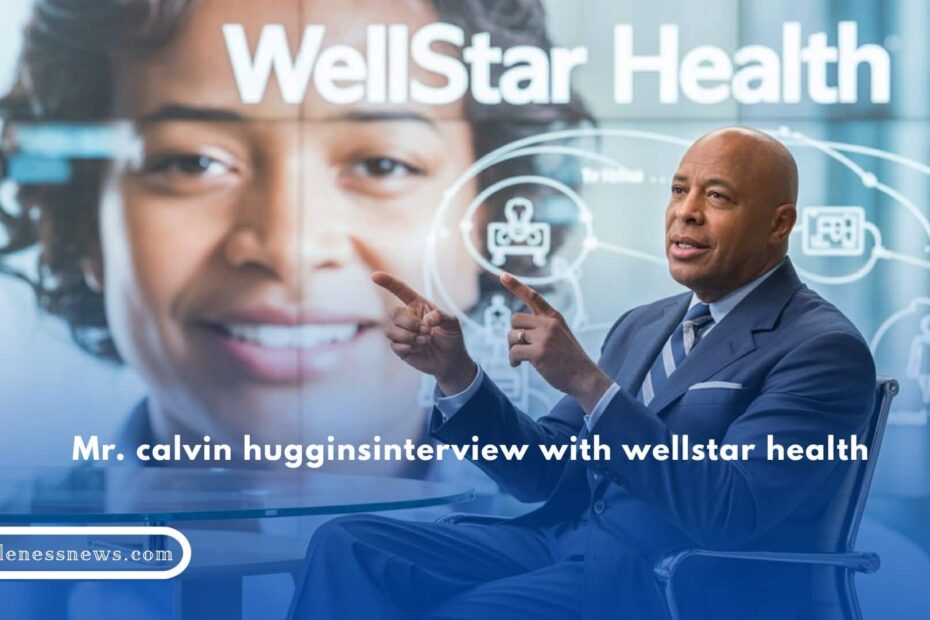In today’s fast-evolving healthcare landscape, few leaders stand out as clearly as Mr. Calvin Huggins. In his recent interview with Wellstar Health, Huggins shared a transformative vision of healthcare—one that seamlessly blends technology, patient-centered care, and community-driven outreach.
This article dives into his insights, humanizes his perspective, and explores how Wellstar Health, under Huggins’ influence, is reshaping how healthcare is delivered and perceived.
Who is Mr. Calvin Huggins?
Mr. Calvin Huggins is a respected figure in the healthcare industry, known for his commitment to health equity, operational efficiency, and community-driven service. As a strategic leader at Wellstar Health, his approach is grounded in empathy, technological advancement, and long-term planning. His work has touched many facets of healthcare, including mental health services, preventive care, and chronic disease management.
Putting People First — The Foundation of Huggins’ Leadership!
Mr. Huggins began by emphasizing the patient-first approach at Wellstar Health. In a system often bogged down by bureaucracy and inefficiencies, his leadership philosophy places human connection at the center. Every care decision, process, and policy is evaluated by one question: Is this good for the patient?
This ethos directly aligns with the broader movement toward value-based care, where outcomes, satisfaction, and patient experiences define success. It’s not just about treating symptoms—it’s about improving lives
How Wellstar Implements Patient-Centered Care – From Empathy to Action!
Building on the theme of human-centric healthcare, Mr. Huggins delved into the operational strategies Wellstar employs to keep patients at the heart of their services. Customized treatment plans, shared decision-making, and emotional support mechanisms are just a few pillars of their patient care model.
This leads into one of the most powerful trends in modern healthcare: personalized medicine. Huggins explained how tailoring healthcare to an individual’s lifestyle, genetics, and community context leads to better long-term health outcomes.
Technology as a Tool, Not a Replacement – Driving Innovation!

While Wellstar Health champions empathy, it doesn’t shy away from technological innovation. Huggins was clear: “Technology is a tool to extend our care, not a substitute for compassion.”
From electronic health records (EHRs) to telehealth platforms, technology is helping streamline communication, improve diagnostic accuracy, and make healthcare more accessible. But the real win is when these tools empower human caregivers to do their jobs better.
This naturally transitions into the next aspect of the conversation: accessibility and outreach.
Expanding Access — Bridging Gaps in Healthcare Delivery!
One of the most pressing challenges in U.S. healthcare is unequal access. Huggins acknowledged this, emphasizing that Wellstar Health is actively working to bridge these gaps.
Their efforts include:
- Mobile health clinics for underserved communities
- Telemedicine services in rural areas
- Transportation partnerships for patient mobility
- Community-based health education programs
This holistic outreach strategy supports not only acute care but also preventive health, the next core theme of the discussion.
Prevention Over Cure — A Paradigm Shift in Public Health!
Mr. Huggins reiterated a growing belief in the healthcare space: proactive care reduces the need for reactive treatment. Wellstar’s emphasis on wellness screenings, lifestyle counseling, and health education reflects this shift.
By promoting preventive medicine, the system aims to reduce hospital admissions, lower healthcare costs, and improve population health metrics.
Naturally, this kind of preventative strategy requires a well-equipped and well-trained workforce, which brings us to the next logical topic: clinical excellence through continuous learning.
Investing in People — Education, Training, And Talent Retention!
As healthcare technologies evolve and community needs shift, the workforce must keep pace. Huggins discussed how Wellstar invests in ongoing education for its medical staff.
Their internal programs focus on:
- Latest treatment guidelines
- Cultural competency
- Emotional intelligence in caregiving
- Data-driven clinical decision-making
This focus on upskilling supports Wellstar’s larger mission of clinical excellence while reinforcing employee satisfaction and retention in the healthcare workforce.
Addressing the Mental Health Crisis – A Whole-Person Approach!

No conversation about modern healthcare is complete without discussing mental health. Huggins expressed serious concern about the growing mental health crisis, especially post-pandemic.
Wellstar has integrated mental health screenings into regular checkups, hired more behavioral health professionals, and expanded its telepsychiatry services. This shows a deep understanding of whole-person care—treating the mind as well as the body.
This comprehensive care model naturally extends to another major area of concern: chronic disease management.
Managing Chronic Illnesses with Compassion and Structure!
Chronic diseases like diabetes, hypertension, and heart failure place enormous stress on the healthcare system. Huggins explained how Wellstar addresses these challenges through structured care pathways.
Patients receive:
- Personalized care plans
- Dietary and lifestyle coaching
- Regular follow-ups
- Medication adherence support
These systems are designed not just to manage diseases but to empower patients to take control of their own health, reinforcing the idea of patient engagement in long-term care.
Cultural Competency – Meeting People Where They Are?
One of the more nuanced aspects of Huggins’ interview was his attention to cultural sensitivity in healthcare. He highlighted the need for understanding patients’ backgrounds, beliefs, and values to build trust and improve outcomes.
Wellstar provides cultural competency training to its staff and incorporates language services, religious considerations, and inclusive care protocols into its service model. This is especially critical when engaging in community health partnerships, the next essential part of Wellstar’s mission.
Collaboration is Key – Working with Communities to Drive Change!
Health is more than a clinical issue—it’s a social one. Huggins detailed how Wellstar collaborates with local schools, nonprofit organizations, and municipal agencies to promote community wellness.
These partnerships allow them to:
- Deliver health literacy programs
- Provide free health screenings
- Conduct vaccination drives
- Tackle food insecurity and housing instability
Through this collective impact model, Wellstar reinforces the idea that healthcare is a shared responsibility.
Crisis Management and Resilience — Learning from the Pandemic!
Huggins also shared how the COVID-19 pandemic shaped their crisis response protocols. They learned the importance of being agile, proactive, and transparent.
By prioritizing:
- Supply chain resilience
- Real-time data analysis
- Frontline staff protection
- Clear public communication
Wellstar strengthened its ability to withstand future health crises. This leads into a broader vision—one that is future-facing and innovation-led.
The Future of Healthcare According to Huggins:
When asked about what’s next, Mr. Huggins spoke of integrated healthcare ecosystems where technology, human touch, and social support intersect.
Some key initiatives on the horizon include:
- Artificial Intelligence in diagnostics
- Expanded home-based care
- AI-driven patient monitoring
- Community wellness hubs
Wellstar Health aims to be a model of adaptive, inclusive, and innovative care—an example for the entire industry.
Smooth Transitions, Big Impact:
As the interview concluded, it became clear that Mr. Calvin Huggins is not just a healthcare administrator—he is a changemaker, advocating for a system that works with patients, for patients.
In an era where many feel disconnected from their health providers, Wellstar’s approach under Huggins’ leadership offers hope. It’s a model rooted in accessibility, empathy, and transformation—and one that many health systems could learn from.
What Healthcare Leaders Can Learn from Huggins?
The interview closed with reflections on leadership. Huggins offered advice that resonates beyond healthcare: “Listen more. Assume less. Empower people. And never lose sight of the human being behind every chart, scan, or diagnosis.” This mindset not only builds organizational trust but ensures that care remains compassionate even as systems become more complex.
FAQs:
1. How does Wellstar use information to help patients?
Wellstar stands out because it focuses on both new technology and strong community care. They try to treat the whole person, not just the illness.
2. How is data being used to improve care under Huggins’ leadership?
Data plays a critical role in refining treatment plans, monitoring patient progress, and forecasting healthcare trends. Huggins supports evidence-based decision-making to personalize care and reduce inefficiencies system-wide.
3. Why is patient feedback important to Wellstar?
Patient input isn’t just collected—it’s acted upon. Huggins champions real-time feedback tools that help identify service gaps, allowing Wellstar to evolve based on what patients actually experience.
4. What is one special program Mr. Huggins helped create?
Huggins has been instrumental in piloting wellness coaching programs for caregivers and family members—recognizing that health outcomes improve when the entire support network is empowered and educated.
5. How does Mr. Huggins support young professionals in healthcare?
He believes in helping new healthcare workers grow by offering them chances to learn, ask questions, and take on leadership roles over time. He also encourages mentorship programs so younger staff can gain confidence from experienced team members.
6. What is one of the biggest goals Mr. Huggins has for Wellstar?
He wants every person—no matter where they live or how much money they have—to get the same high-quality care. To make this happen, he focuses on building more clinics and improving digital access to care.
7. How does Wellstar help patients feel more comfortable during care?
They use kind communication, friendly staff, and simple tools to make sure patients don’t feel lost or afraid during treatment. Even small changes, like clear instructions and follow-up calls, help people feel cared for and safe.
Conclusion:
The interview with Mr. Calvin Huggins gave us a compelling look into the heart of Wellstar Health’s mission. His leadership is helping shape a future where healthcare isn’t just about curing illnesses, but about building healthier lives, stronger communities, and a more equitable system for all.
Through telehealth, inclusive care models, professional development, and a deep respect for mental health and community wellness, Mr. Huggins is setting a new standard in modern medicine.
Latest Post:
